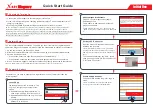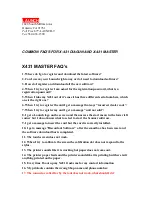
36
User's Guide HDSPe MADI FX
© RME
23. Connections
23.1 MADI I/O
The BNC input is built according to AES10-1991. The input impedance is 75 Ohm. It will oper-
ate error-free from about 180 mVpp on.
The optical input and output uses a FDDI (ISO/IEC 9413-3) compatible optical module, accord-
ing to AES10-1991. More information can be found in chapter 30.1, MADI Basics.
HDSPe MADI FX includes automatic input selection (Redundancy Mode). In case the current
input signal fails, the unit switches to the other input immediately. This mode, called redundancy
operation, offers improved safety against errors on the transmission line. Switching the inputs is
done in less than a sample and - provided the input signal fails abruptly – click free.
The BNC output is built according to AES10-1991. The output's impedance is 75 Ohm. The
output voltage will be 600 mVpp when terminated with 75 Ohm. In
MADI1 output mirror mode
output 2 and 3 hold the same signal as MADI port 1. This mode allows for distributing a signal
to three destinations, or redundant operation at the output of the card.
23.2 AES/EBU
The XLR AES/EBU input and output are transformer-balanced and ground-free. The incoming
channel status is ignored. Connection is accomplished using balanced cables with XLR plugs.
AES/EBU (and SPDIF) can contain Emphasis information. Audio signals with Emphasis have a
strong high frequency boost, requiring high frequency attenuation on playback.
An Emphasis indication gets lost as there exists no standardized interface on computers to
handle this information!
Input
Thanks to a highly sensitive input stage
SPDIF coaxial can be fed too by using a sim-
ple cable adapter phono/XLR. To achieve
this, pins 2 and 3 of a male XLR plug are
connected individually to the two pins of a
phono plug. The cable shielding is only con-
nected to pin 1 of the XLR - not to the phono
plug.
Output
Using the cable adapter XLR/phono described above, devices with coaxial SPDIF interface can
be connected to the AES output of the HDSPe MADI FX as well. Note that most consumer
equipment with phono (SPDIF) inputs will only accept signals having a Channel Status ‘Con-
sumer’ format. The Consumer status is activated in the Settings dialog. In Consumer mode the
output voltage is reduced as well, as SPDIF calls for a lower voltage than AES/EBU.
The output signal coding of the HDSPe MADI FX has been implemented according to AES3-
1992 Amendment 4:
•
32 / 44.1 / 48 kHz, 64 / 88.2 / 96 kHz, 176.4 / 192 kHz depending on the current sample rate
•
Audio
use
•
No Copyright, Copy permitted
•
Format Professional or Consumer
•
Category General, Generation not indicated
•
2-Channel, No Emphasis
•
Aux Bits Audio use, 24 Bit
•
Origin:
RME
Summary of Contents for Hammerfall HDSPe MADI FX
Page 5: ...User s Guide HDSPe MADI FX RME 5 User s Guide HDSPe MADI FX General...
Page 26: ...26 User s Guide HDSPe MADI FX RME...
Page 35: ...User s Guide HDSPe MADI FX RME 35 User s Guide HDSPe MADI FX Inputs and Outputs...
Page 41: ...User s Guide HDSPe MADI FX RME 41 User s Guide HDSPe MADI FX TotalMix FX...
Page 43: ...User s Guide HDSPe MADI FX RME 43...
Page 74: ...74 User s Guide HDSPe MADI FX RME...
Page 75: ...User s Guide HDSPe MADI FX RME 75 User s Guide HDSPe MADI FX Technical Reference...
















































